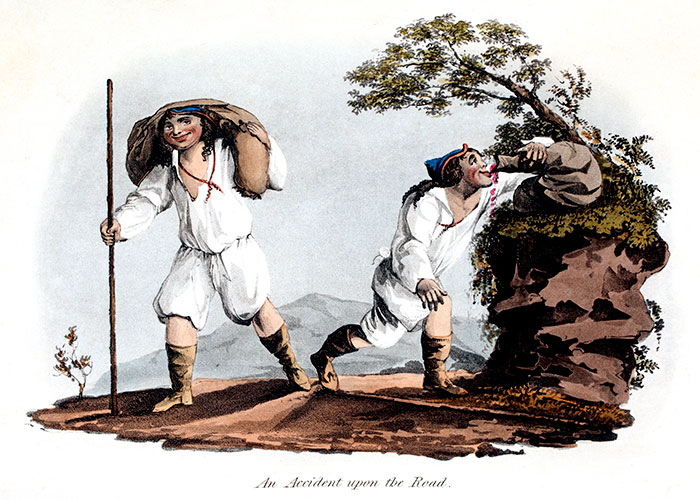engraving and text extracted from
History of Madeira - 1821 (from my library)
Madeira was then under British domination
Twine-carrier
An accident on the road
As the characteristic circumstance displayed in the plate admits of an humorous idea, an humorous title has been given to it, but altogether consistent with the natural habits of the peasants employed in the office of Wine-carriers. When the grapes have been duly pressed, the wine is carried by peasants, as represented in the plate, in goatskins, to a store, where it is emptied into suitable vats, or vessels, for the process of fermentation. Such is the fatigue occasioned by the inequalities of the road, and the usual heat of the season, that these carriers are sometimes tempted to refresh and sustain themselves, by taking certain liberties with their loads, which extreme thirst suggests, and favourable opportunities encourage. Sometimes a goat's skin may burst from unavoidable accidents, which give a right to the overflowing juice ; but, under very pressing circumstances of thirst and weariness, it may so happen, that an artificial accident is contrived to relieve them. The wine in this state acts as an enlivener and restorative without any subsequent stupor.
This plate gives so distinct a view of the dress of these people, that a description of it will not find a more suitable place than on this page. Its form is correctly represented by the pencil ; and it only remains for the pen to add, that it consists of a kind of linen cloth, manufactured by the women. It is at once light, and of a close texture, so that it is equally calculated for the different seasons, and possesses a firmness of fabric that promises a peculiar length of wear and tear. Their heads are covered with a cloth cap verging to a point; while their hair hangs in long ringlets down their backs. They wear round their necks a ribbon, which answers in its length to the measurement of the figure of their patron saint. To this personal decoration they attach the character of a religious talisman.
Whether it were a froward thrust
That compels the skin to burst,
Urg’d by the bearer’s daring thirst
Or whether he his throat is filling
To save the precious juice from spilling,
And that this native spring of mirth,
Should not be cast on barren earth
Can, ’tis presum’d, be only known
To that same pleasant thought alone,
Which, tender of the flowing wine,
Display’d the humorous design.
But, whatsoe’er the truth may be,
A gen’rous, kind philosophy
Will not the welcome bev’rage grudge
To the poor, thirsty, swelt’ring drudge,
Who, as his weary way he saunters,
The goat’s-skin in his lips decanters,
To give him spirits on his way,
And make his future journey gay.
While we view the bleeding skin,
And see him suck the juice within.
’Tis a hard heart who here would blame :
Nine out of ten would do the same.
The costumes :
This engraving gives a very accurate view of the dress of this people, that a description of it will find no more appropriate place than on this page. Its form is correctly represented by the pencil; and it only remains for the pen to add, that it is a kind of linen cloth, made by the women. It is both light and tightly textured, so that it is also designed for the different seasons, and has a firmness of fabric which promises a particular length of wear. Their heads are covered with a cloth cap that ends in a point, while their hair hangs in long curls down their backs. They wear a ribbon around their necks, the length of which corresponds to the size of the figure of their patron saint. To this personal decoration they attach the character of a religious talisman (original text).
To this must be added the walking stick for stony paths and soft leather boots. It should be noted that if the linen clothes are without decoration, it is not the same for the bonnets with a red border.
... In all of these engravings, the workers and farmers are mostly dressed in crisp white cloth. Given their work on the roads and in the fields, we can assume that the actual colour was rather greyish... ?


![]()














